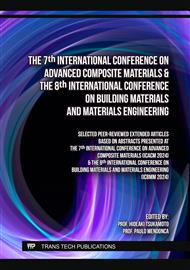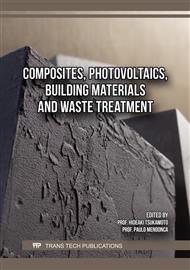[1]
Benallel A, Tilioua A, Ettakni M, Ouakarrouch M, Garoum M, Ahmed Alaoui Hamdi M (2021) Design and thermophysical characterization of new thermal insulation panels based on cardboard waste and vegetable fibers. Sustainable Energy Technologies and Assessments
DOI: 10.1016/j.seta.2021.101639
Google Scholar
[2]
Muthuraj R, Lacoste C, Lacroix P, Bergeret A (2019) Sustainable thermal insulation biocomposites from rice husk, wheat husk, wood fibers and textile waste fibers: Elaboration and performances evaluation. Ind Crops Prod 135:238–245
DOI: 10.1016/j.indcrop.2019.04.053
Google Scholar
[3]
Rahman SS, Siddiqua S, Cherian C (2022) Sustainable applications of textile waste fiber in the construction and geotechnical industries: A retrospect. Clean Eng Technol
DOI: 10.1016/j.clet.2022.100420
Google Scholar
[4]
Rubino C, Aracil MB, Gisbert-Payá J, Liuzzi S, Stefanizzi P, Cantó MZ, Martellotta F (2019) Composite eco-friendly sound absorbing materials made of recycled textilewaste and biopolymers. Materials
DOI: 10.3390/ma12234020
Google Scholar
[5]
Baccouch W, Ghith A, Yalcin-Enis I, Sezgin H, Miled W, Legrand X, Faten F (2022) Investigation of the mechanical, thermal, and acoustical behaviors of cotton, polyester, and cotton/polyester nonwoven wastes reinforced epoxy composites. Journal of Industrial Textiles 51:876–899
DOI: 10.1177/1528083720901864
Google Scholar
[6]
Aly NM, Seddeq HS, Elnagar K, Hamouda T (2021) Acoustic and thermal performance of sustainable fiber reinforced thermoplastic composite panels for insulation in buildings. Journal of Building Engineering
DOI: 10.1016/j.jobe.2021.102747
Google Scholar
[7]
Bogale M, Sakthivel S, Senthil Kumar S, Senthil Kumar B (2023) Sound absorbing and thermal insulating properties of recycled cotton/polyester selvedge waste chemical bonded nonwovens. Journal of the Textile Institute 114:134–141
DOI: 10.1080/00405000.2021.2024377
Google Scholar
[8]
Islam S, Bhat G (2019) Environmentally-friendly thermal and acoustic insulation materials from recycled textiles. J Environ Manage
DOI: 10.1016/j.jenvman.2019.109536
Google Scholar
[9]
Sakthivel S, Senthil Kumar S, Melese B, Mekonnen S, Solomon E, Edae A, Abedom F, Gedilu M (2021) Development of nonwoven composites from recycled cotton/polyester apparel waste materials for sound absorbing and insulating properties. Applied Acoustics
DOI: 10.1016/j.apacoust.2021.108126
Google Scholar
[10]
Sezgin H, Kucukali-Ozturk M, Berkalp OB, Yalcin-Enis I (2021) Design of composite insulation panels containing 100% recycled cotton fibers and polyethylene/polypropylene packaging wastes. J Clean Prod
DOI: 10.1016/j.jclepro.2021.127132
Google Scholar
[11]
Shalwan, A., Alajmi, A., & Yousif, B. F. (2022). Theoretical Study of the Effect of Fibre Porosity on the Heat Conductivity of Reinforced Gypsum Composite Material. Polymers, 14(19)
DOI: 10.3390/polym14193973
Google Scholar
[12]
Liu, H., & Zhao, X. (2022). Thermal Conductivity Analysis of High Porosity Structures with Open and Closed Pores. International Journal of Heat and Mass Transfer, 183
DOI: 10.1016/j.ijheatmasstransfer.2021.122089
Google Scholar
[13]
Hung Anh LD, Pásztory Z (2021) An overview of factors influencing thermal conductivity of building insulation materials. Journal of Building Engineering
DOI: 10.1016/j.jobe.2021.102604
Google Scholar
[14]
Korpayev, S., Bayramov, M., Durdyev, S., Hamrayev, H., Baymyradova, D., & Nurmuhammedov, A. (2023). Effect of stone wool waste from greenhouse agriculture in brick production. Journal of Building Engineering, 63
DOI: 10.1016/j.jobe.2022.105340
Google Scholar
[15]
Papadopoulos, A. M., Karamanos, A., & Avgelis, A. (2002). ENVIRONMENTAL IMPACT OF INSULATING MATERIALS AT THE END OF THEIR USEFUL LIFETIME. Proceedings of the Conference Protection and Restoration of the Environment VI.
Google Scholar



